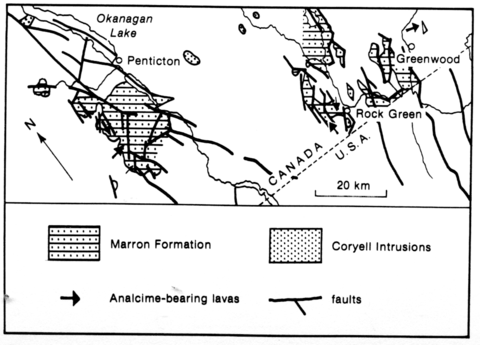stripes
The Marron Formation is a sequence of early Tertiary lavas associated with which are a number of intrusions, referred to as the Coryell Intrusions, which are thought to be consanguineous. Both lavas and intrusions probably extend beyond the area indicated by the map (Fig. 22), including southwards into the United States. The Marron Formation lavas include pyroxene andesites, trachyandesites, sodic trachytes and phonolites with a maximum thickness of about 2000 m. Only the lowermost part of the sequence is alkaline with a basal biotite-pyroxene phonolite containing anorthoclase rhombs, primary analcime phenocrysts up to several millimetres in diameter, as well as aegirine, nepheline and a little olivine. These rocks were referred to as 'shackanite' by Daly (1912) and their genesis is discussed by Church (1978) and Edgar (1979). The Coryell Intrusions range from granites through syenites to monzonite. Most of the rocks include alkali feldspar, andesine-labradorite, a pyroxene, apparently varying from augite to aegirine, hornblende, biotite, altered olivine and possible altered nepheline. The petrology has not been studied thoroughly, and other intrusions in the area not included as 'Coryell Intrusions' may prove to be part of the alkaline suite. A study of K, U and Th in six Coryell Intrusions has been made by Burwash and Berndt (1982).
BURWASH, R.A. and BERNDT, K.A. 1982. Uranium in alkaline intrusions, southeastern British Columbia. Paper, Geological Survey of Canada, 81-23: 31-6.
CHURCH, B.N. 1973. Geology of the White Lake Basin. Bulletin, British Columbia Department of Mines and Petroleum Resources, 61: 1-120.
CHURCH, B.N. 1978. Shackanite and related analcite-bearing lavas in British Columbia. Canadian Journal of Earth Sciences, 15: 1669-72.
CURRIE, K.L. 1976a. The alkaline rocks of Canada. Bulletin, Geological Survey of Canada, 239: 1-228.
DALY, R.A. 1912. Geology of the North American Cordillera at the Forty-Ninth Parallel. Memoir, Geological Survey of Canada, 38, part 1: 1-546.
EDGAR, A.D. 1979. Shackanite and related analcite-bearing lavas in British Columbia: discussion. Canadian Journal of Earth Sciences, 16: 1298-9.
LITTLE, H.W. 1983. Geology of the Greenwood Map-Area, British Columbia. Paper, Geological Survey of Canada, 79-29: 1-37.
MONGER, J.W.H. 1968. Early Tertiary stratified rocks, Greenwood map-area, British Columbia. Paper, Geological Survey of Canada, 67-42: 1-39.

